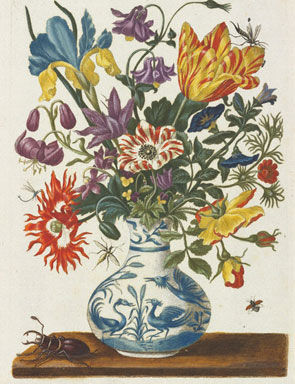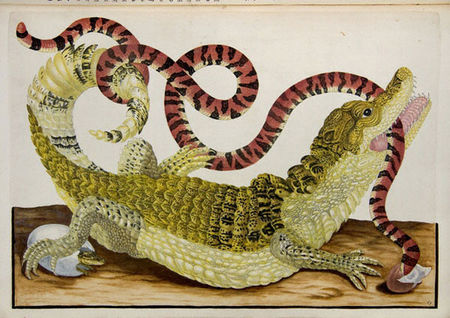"Maria Sibyllam Merian and Daughters: Women of Art and Science" au Getty Center
Maria Sibylla Merian (German, 1647 - 1717), Spring Bouquet in a Chinese Vase, from The New Book of Flowers, volume 3, 1680. Hand-colored engraving. 32.6 x 40.2 x 9.5 cm (EX.2008.2.40 Trustees of the Natural History Museum, London, England, S.B.635.9 MER-Q. Specimen on loan courtesy of the Trustees of the Natural History Museum, London.
LOS ANGELES.- This exhibition charts the artistic and scientific explorations of German artist Maria Sibylla Merian (1647–1717) and her daughters Johanna Helena and Dorothea Maria. Enterprising and adventurous, these women raised the artistic standards of natural history illustration and helped transform the field of entomology, the study of insects. The exhibition presents books, prints, and watercolors by Merian and her contemporaries and features one of the greatest illustrated natural history books of all time, The Insects of Suriname.
Predecessors
From about 1450, European artists increasingly took inspiration from nature, studying the details of insects, animals, flowers, and plants. Maria Sibylla Merian enriched this tradition.
The creator of this drawing, Georg Flegel, had a lasting impact on still life painting in Frankfurt, Merian's native city. Flegel portrayed crawling insects, especially wasps and beetles, with convincing naturalism. In this watercolor, the meticulously rendered hornet is proportionally larger than the ornamental flowers.
Beginnings
Maria Sibylla Merian was born in 1647 in Frankfurt, Germany, into a middle-class family of publishers and artists. Her father, Matthäus Merian the Elder, published some of the most influential natural history texts of the 1600s.
Merian's stepfather, Jakob Marrel, had been trained by the artist and art dealer Georg Flegel (see image above). He introduced the young Merian to the art of miniature flower painting against her mother's will. Merian learned how to draw, mix paints, paint in watercolor, and make prints alongside Marrel's male pupils.
Merian's interest in insects was stimulated by the practice of silkworm breeding that was introduced by Frankfurt's silk trade. She began to observe caterpillars, moths, and butterflies, and by the age of 13 she had already observed the metamorphosis of a silkworm—a discovery that pre-dated published accounts by almost ten years.
Merian made this watercolor of a pomegranate plant emerging from the ground when she was not yet 20. She uniquely conveyed the passage of time by contrasting ripe fruit on the branches with the overripe fruit on the ground.
The New Book of Flowers
Merian married her stepfather's favorite pupil, Johann Andreas Graff (German, 1636–1701), at the age of 18 and later moved with him to his native Nuremberg. There, she instructed the daughters of respected citizens in embroidery and painting.
Merian ingeniously combined her backgrounds in publishing and flower painting to produce The New Book of Flowers, a plate from which is shown here. Comprised of three volumes, each with twelve plates of engravings, this book of flowers, wreaths, nosegays, and bouquets served as a model book for artists, embroiderers on silk, and cabinetmakers. With this function in mind, Merian portrayed each flower in this plate distinctly, without overlap.
Merian's flower books were heavily used and often damaged, and surviving, intact copies such as the one on view in this exhibition are exceedingly rare.
The Caterpillar Book
While in Nuremberg, Merian wrote the first volume of her two-volume book Caterpillars, Their Wondrous Transformation and Peculiar Nourishment from Flowers (or simply The Caterpillar Book). Merian depicted moths and butterflies in various stages of metamorphosis, the process by which they transform from egg to caterpillar to adult. Each image was organized around a single plant and was accompanied by a text in which Merian described the colors, forms, and timing of each stage of transformation. By including the caterpillars' food sources in her natural history illustrations, Merian brought a more ecological approach to the study of metamorphosis.
Merian's work helped to disprove the common belief that insects reproduced by spontaneous generation from decaying matter such as old meat or rotten fruit, and her aesthetic sensitivity raised the standards of scientific illustration.
This study for The Caterpillar Book shows the caterpillar of the bright-line brown-eye moth on its host plant, the common plantain. The caterpillar is hard to find, as its vivid green color is perfectly camouflaged on the plantain's flowers.
A Woman's Business in Amsterdam
By 1686 Merian had left her husband and moved with her two daughters and elderly mother to a religious community north of Amsterdam, The Netherlands. While living in this community, Merian pursued her research as a reflection of God's handiwork.
In 1691, after the financial collapse of the religious community, Merian and her daughters moved to Amsterdam, the center of world trade and the third largest city in Europe. Johanna Helena and Dorothea Maria learned their mother's art. The three women set up a studio together, painting plants, birds, and insects and making works of art based on the most compelling images in The Caterpillar Book.
Johanna Helena also developed her own career as a flower painter. This watercolor presents a highly accurate rendering of a magnificent species of fritillary. Like Johanna Helena's other portraits of flowers, it has a monumental presence that almost fills the sheet. The blossoms that encircle the stalk impart a sculptural quality that enhances the drawing's illusionism.
The Insects of Suriname
Merian's artistic and scientific interests outgrew Amsterdam's supply of exotic plants and animals. In 1699, after selling most of her belongings, she set sail for the Dutch colony of Suriname with her younger daughter, Dorothea Maria. Maria Sibylla was 52, Dorothea Maria 21.
The jungles of South America were teeming with live specimens, which Merian studied for her most important publication, The Metamorphosis of the Insects of Suriname (known as The Insects of Suriname). Merian's experiences in the city of Paramaribo are expressed in her accounts of vibrant butterflies, voracious caterpillars and ants, exotic fruits and vegetables, menacing reptiles, and treacherous explorations into the jungle. Her observations about the local climate, the use of plants and animals, and the Dutch colonists' treatment of slaves provide some of the earliest accounts of life in Suriname.
In the text that accompanied this image, Merian gave an indication of the conditions under which she worked in Suriname: "When I painted, [wasps] flew before my eyes and hummed around my head. Near my paint-box they built a nest of mud." One of these bothersome wasps appears here, flying decoratively under the arch of the red bract.
In 1701, poor health and Suriname's hot and humid climate forced Merian to return to Amsterdam. Her daughter Dorothea Maria probably assisted in making preparatory watercolors for The Insects of Suriname, and an unidentified Amerindian woman who accompanied them home likely provided details about Surinamese plants and animals. The book, published in 1705, was sold in three different versions, including a deluxe version with hand-colored transfer prints that retained the vivid naturalism of Merian's preparatory watercolors.
Spreading the Merian Name
Maria Sibylla Merian died in 1717. Near the time of her death, her watercolors were purchased for Czar Peter the Great of Russia. Shortly thereafter, Dorothea published a third volume of The Caterpillar Book with 50 more of her mother's observations and an appendix on insects observed by Johanna Helena, who had moved to Suriname in 1711.
Around 1718 Dorothea moved to Saint Petersburg, where she continued to work as an artist. To ensure the circulation of her mother's work, she sold the plates of The Insects of Suriname to a Dutch publisher, who reissued the book in 1719 with 12 additional plates. Thanks to her daughters' continued diligence, Merian left a lasting mark on entomology.
Maria Sibylla Merian (German, 1647 - 1717), Dwarf Caiman and False Coral Snake from The Insects of Suriname, 1719. Hand-colored etching. 87.5 x 53 cm EX.2008.2.14. Universiteitsbibliotheek, Groningen, Netherlands, 699Z. Photo: Dirk Fennema, Haren (Netherlands)

/https%3A%2F%2Fprofilepics.canalblog.com%2Fprofilepics%2F1%2F0%2F100183.jpg)
/https%3A%2F%2Fstorage.canalblog.com%2F03%2F02%2F119589%2F96711876_o.jpg)
/https%3A%2F%2Fstorage.canalblog.com%2F11%2F31%2F119589%2F94773502_o.jpg)
/https%3A%2F%2Fstorage.canalblog.com%2F20%2F83%2F119589%2F94772815_o.jpg)
/https%3A%2F%2Fstorage.canalblog.com%2F26%2F72%2F119589%2F75604929_o.jpg)
/https%3A%2F%2Fstorage.canalblog.com%2F59%2F60%2F119589%2F26458628_o.jpg)




/image%2F1371349%2F20240504%2Fob_93e6fc_440746014-1663431631093516-33520012940.jpg)
/image%2F1371349%2F20240504%2Fob_ad891b_441216662-1663349251101754-34964046851.jpg)
/image%2F1371349%2F20240504%2Fob_aed9af_441052920-1663343744435638-38708661590.jpg)
/image%2F1371349%2F20240504%2Fob_d96259_441052920-1663343744435638-38708661590.jpg)